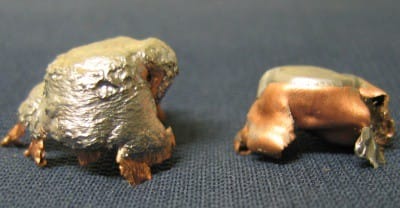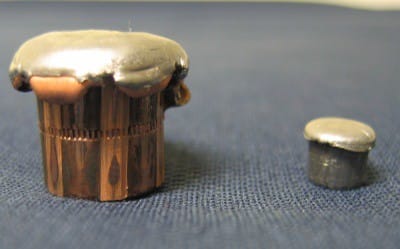
There is no such thing as a magic bullet. That is why we have such a wide variety of bullets in the marketplace. Depending on the kind of hunting you are doing there is, without a doubt, at least one bullet that will suit your needs perfectly. So with all these bullets out there how do you know which one is right for you? The following steps will break it down and help you focus on the important factors in selecting the right bullet.
Know the animal you are hunting.
In the movie “Predator” just after one of the soldiers empties a mini-gun on an alien and draws florescent green blood, Arnold Schwarzenegger’s character drops one of the best one liners ever, “if it bleeds we can kill it.” That holds true for anything running around the earth. But to kill anything you’ve got to do one of two things.
1. Shut down it’s circulatory system and starve the brain of oxygen. That means take out the heart and/or the lungs which supply the blood with oxygen and the animal will die shortly thereafter.
2. Cause massive damage to the brain and or central nervous system, which shuts down all other internal systems.
Animals will not react sympathetically to being shot. They don’t know what jumped up and bit them, so the hunter must physically kill them. And to do that efficiently you must use a bullet that is more than capable of penetrating deeply enough while causing catastrophic damage to the heart and/or lungs or the central nervous system. It stans to reason that you wouldn’t use a varmint bullet to penetrate the deep chest cavity of a bull elk.
Know the area you are hunting.
The plains of West Texas will require a very different hunting and shooting style and bullet than the swamps of South Georgia. So pick a bullet that is designed for the kind of hunting you will be doing.
In the swamp much of the hunting is stand hunting and if you shoot a deer you still have to sit in the stand until the game manager comes to pick you up, so you want a bullet that will expand rapidly while still delivering adequate penetration to stop animals very quickly, thus eliminating late night tracking. If your hunting is going to require shots out to 300 yards, then a lighter faster bullet will make longer range shooting a bit easier. If you are hunting in a heavily wooded area it’s been proven that bullets with a high sectional density traveling at a moderate velocity tend to deflect less than both slow, heavy projectiles and light, fast projectiles. So know what kind of shots you are going to be taking and select a bullet that is right for your geographical area. Use the right bullet in the right place.
Know your bullet cartridge combination.
Take the time and thoroughly research the bullets you are considering for your hunting. There are many bullets out there and the bullet that is exactly right for your hunting is available. There are many styles of hunting bullets from bonded bullets to bullets designed to give rapid expansion, and deep penetration to controlled expansion bullets for tough, heavy game. It is critical that you study the bullets that you are considering for use.
Talk to the manufacturers of the bullets, that is why they have technical service hotlines and email addresses. Tell them what kind of hunting you are doing and ask them which bullet in their line that they recommend and then study their answer. Pick the top three bullets that meet your hunting criteria and get a box of each, load them up and see how they shoot and pick the most accurate one. Even the best bullet in the world won’t do the job if it won’t go where you tell it to
Practice makes perfect.
Now you’ve picked a bullet that will do the job, you are confident in that bullet’s level of accuracy in your rifle. It’s your turn—you have to do is get out there and become proficient with your gun. Shooting two rounds from the bench the day before season opens, calling the rifle zeroed and then going hunting is simply not adequate. You need to have a good knowledge of your rifle, knowing the location of the safety should be second nature. You should know the trigger and when it will break. Knowing and accepting your limitations as a shooter are important, or practice to overcome them. And do not practice from the bench, period.
You owe yourself to be the best that you can be and you owe the game animal you are hunting a humane death. Practice as you will shoot in the field, not from a cement bench rest. That is just for zeroing your rifle.

The bullet on the left is a .30-caliber, 150-grain Hornady InterBond bullet and the one on the right is a Hornady .30-caliber, 155-grain A-MAX bullet. Both bullets expanded, however the InterBond retained a great deal more weight and penetrated nearly 10 inches deeper in 10-percent ordnance gelatin than the 155-grain A-MAX.

These two bullets illustrate that controlled expansion can be found at both ends of the spectrum. The bullet on the right is a 40-grain, hollow-point fired from a .22 LR cartridge, the bullet on the left is a 325-grain bullet fired from a .45-70 LeverEvolution cartridge. Both demonstrate excellent expansion characteristics. The .22 LR penetrated just over one foot and the .45-70 round penetrated just under three feet.



